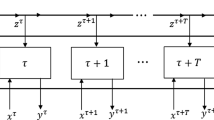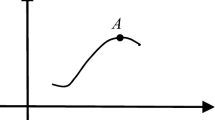Abstract
Congestion is an essential concept in production systems, where the increase (decrease) of at least one of the inputs leads to the decrease (increase) of at least one of the outputs without any adverse effect on the other inputs or outputs. Various methods have been presented to calculate congestion. According to the literature, previous methods can only identify the existence of congestion of decision-making units (DMUs) with negative data without measuring its value. Due to the importance of negative data in the real world, this study determines the congestion amount of DMUs with negative data. This article aims to determine the excess amount of inputs and the lack of outputs caused by the congested DMUs with negative inputs and outputs. This study proposes two methods to specify the value of congestion of units with negative resources and products. As well as in this survey, the use of inverse DEA is employed to identify and determine the congestion amount of DMUs. The presented model prevents the inappropriate allocation of resources in an organization. Also, identifying the best and worst congestion units allows the manager to improve the performance of congested DMUs with an appropriate method. A numerical example is utilized to demonstrate the superiority of the proposed methods over the previous methods. Besides, the presented methods can be employed in various fields according to the established models.

Similar content being viewed by others
References
Amin, G.R., Emrouznejad, A., Gattoufi, S.: Modelling generalized firms’ restructuring using inverse DEA. J. Prod. Anal. 48, 51–61 (2017)
Amin, G.R., Al-Muharrami, S.: A new inverse data envelopment analysis model for mergers with negative data. IMA J. Manage. Math 29, 137–149 (2018)
Asgharian, M., Khodabakhshi, M., Neralic, L.: Congestion in stochastic data envelopment analysis: an input relaxation approach. Int. J. Stat. Manag. Syst. 5(1), 84–106 (2010)
Brockett, P.L., Cooper, W.W., Shin, H.C., Wang, Y.: Inefficiency and congestion in Chinese production before and after the 1978 economic reforms. Socio-Econ. Plan. Sci. 32, 1–20 (1998)
Charnes, A., Cooper, W.W., Rhodes, E.: Measuring the efficiency of DMUs. Eur. J. Oper. Res. 2, 429–444 (1978)
Chen, L., Wang, Y., Lai, F., Feng. F.: An investment analysis for china’s sustainable development based on inverse data envelopment analysis. J. Clean. Prod. (2016)
Cooper, W.W., Thompson, R.G., Thrall, R.M.: Introduction: extensions and new developments in DEA. Ann. Oper. Res. 66, 3–45 (1996)
Cooper, W.W., Deng, H., Huang, Z.M., Li, S.X.: One model approach to congestion in data envelopment analysis. Socioecon. Plann. Sci. 36, 231–238 (2002)
Ebrahimzadeh Adimi, M., Rostamy-Malkhalifeh, M., Hossienzadehlotfi, F., Mehrjoo, R.: A new linear method to find the congestion hyperplane in DEA. Math. Sci. 13, 43–52 (2019)
Fang, L.: Congestion measurement in nonparametric analysis under the weakly disposable technology. Eur. J. Oper. Res. 245, 203–208 (2015)
Fare, R., Svensson, L.: Congestion of production factors. Econometrica 48, 1745–1752 (1980)
Fare, R., Grosskopf, S.: Measuring congestion in production. Zeitschrift fur Nationaiokonomie 43, 257–271 (1983)
Fuentes, R., Bellver-Domingo, A., Hernández-Chover, V., Hernández-Sancho, F.: Identification and correction of congestion in wastewater treatment plants in the Community of Valencia, Spain. Environ. Sci. Pollut. Res. 27, 15729–15742 (2020)
Gattoufi, S., Amin, G.R., Emrouznejad, A.: A new inverse DEA method for merging banks. J. Manag. Math. 25, 73–87 (2014)
Gerami, J., Mozaffari, M.R., Wanke, P.F., Correa, H.L.: A generalized inverse DEA model for firm restructuring based on value efficiency. IMA J. Manag. Math. (2021). https://doi.org/10.1093/imaman/dpab043
Ghobadi, S.: Merging decision-making units with interval data. Rairo-Oper. Res 55, S1605–S1631 (2021)
Guijarro, F., Martinez-Gomez, M., Visbal-Cadavid, D.: A model for sector restructuring through genetic algorithm and inverse DEA. Expert Syst. Appl. 154, 1113422 (2020)
Hadi-Vencheh, A., Foroughi, A.A.: A generalized DEA model for inputs/outputs estimation. Math. Comput. Model. 43, 447–457 (2006)
Hadi-Vencheh, A., Foroughi, A.A., Soleimani-damaneh, M.: A DEA model for resource allocation. Econ. Model. 25, 983–993 (2008)
Hajaji, H., Yousefi, S., Sean, R.F., Hassanzadeh, A.: Recommending investment opportunities given congestion by adaptive network data envelopment analysis model: assessing sustainability of supply chains. Rairo-Oper. Res. 55, 21–49 (2021)
Jahanshahloo, G.R., Khodabakhshi, M.: Suitable combination of input for improving outputs in DEA with determining input congestion: considering textile industry of China. Appl. Math. Comput. 151(1), 263–273 (2004)
Jahanshahloo, G.R., Hosseinzadeh Lotfi, F., Rostamy Malkhalifeh, M., Ghobadi, S.: Using enhanced Russell model to solve inverse data envelopment analysis problems. Hindawi Publ. Corp. Sci. World J. 2014, 1–10 (2014)
Jahanshahloo, G.R., Soleimani-damaneh, M., Ghobadi, S.: Inverse DEA under inter-temporal dependence using multiple-objective programming. Eur. J. Oper. Res. 240, 447–456 (2015)
Kao, C.: Congestion measurement and elimination under the framework of data envelopment analysis. Int. J. Prod. Econ. 123(2), 257–265 (2010)
Kheirollahi, H., Hessari, P.: An input relaxation model for evaluating congestion in fuzzy DEA. Croatian Oper. Res. Rev. 8(2), 391–408 (2017)
Khezri, S., Dehnokhalaji, A., Hosseinzadeh Lotfi, F.: A full investigation of the directional congestion in data envelopment analysis. RAIRO-Oper. Res. 55, 571–591 (2021)
Khoveyni, M., Eslami, R., Khodabakhshi, M., Jahanshahloo, G.R., Hosseinzadeh Lotfi, F.: Recognizing strong and weak congestion slack based in data envelopment analysis. Comput. Indus. Eng. 64, 731–738 (2013)
Khoveyni, M., Eslami, R., Yang, G.: Negative data in DEA: Recognizing congestion and specifying the least and the most congested decision making units. Comput. Oper. Res. 79, 39–48 (2017)
Mahmoodirad, A., Sanei, M.: Solving a multi-stage multi-product solid supply chain network design problem by meta-heuristics. Scientia Iranica 23, 1429–1440 (2016)
Mehdiloozad, M., Zhu, J., Biresh, K.: Identification of congestion in data envelopment analysis under the occurrence of multiple projection: a reliable method capable of dealing with negative data. Eur. J. Oper. Res. 265, 644–654 (2018)
Sharma, M.J., Yu, S.J.: Multi-stage data envelopment analysis congestion model. Oper. Res. 13, 399–413 (2013)
Molla-Alizadeh-Zavardehi, S., Mahmoodirad, A., Sanei, M., Niroomand, S., Banihashemi, S.: Metaheuristics for data envelopment analysis problems. Int. J. Syst. Sci. Oper. Logist. 8(4), 371–382 (2021)
Noura, A.A., Jahanshahloo, G.R., Hosseinzadeh Lotfi, F., Fanati Rashidi, S., Parker, B.R.: A new method for measuring congestion in data envelopment analysis. Socio-Econ. Plan. Sci. 44, 240–246 (2010)
Portela, M.C.A.S., Thanassoulis, E., Simpson, G.G.: A directional distance approach to deal with negative data in DEA: an application to bank branches. J. Oper. Res. Soc. 55, 1111–1121 (2004)
Ren, X.T., Jiang, C., Khoveyni, M., Guan, Z.: A review of DEA mrthods to identify and measure congestion. J. Manag. Sci. Eng. 6, 345–362 (2021)
Ren, X.T., Fukuyama, H., Yang, G.L.: Eliminating congestion by increasing inputs in R&D activities of Chinese universities. Omega 110, 102618 (2022)
Sahoo, B.K., Tone, K.: Radial and non-radial decompositions of profit change: with an application to Indian banking. Eur. J. Oper. Res. 196, 1130–1146 (2009)
Scheel, H.: Undesirable outputs in efficiency valuations. Eur. J. Oper. Res. 132, 400–410 (2001)
Seiford, L.M., Zhu, J.: Modeling undesirable factors in efficiency evaluation. Eur. J. Oper. Res. 142, 16–20 (2002)
Shadab, M., Saati, S., Farzipoor Saen, R., Khoveyni, M., Mostafaee, A.: Measurung congestion in sustainable supply chain based on data envelopment analysis. Neural Comput. Appl. (2021). https://doi.org/10.1007/s00521-021-05889-9
Shahsavan, T., Sanei, M., Tohidi, Gh., Hosseinzadeh Lotfi, F., Ghobadi, S.: A new method of determining decision-making unit congestion under inter-temporal dependence. Soft Comput. 26, 2063–2073 (2022)
Sharp, J.A., Meng, W., Liu, W.: A modified slack-based measure model for data envelopment analysiswith natural negative outputs and inputs. J. Oper. Res. Soc. 58, 1672–1677 (2007)
Sueyoshi, T., Sekitani, K.: DEA congestion and return to scale under an occurrence of multiple optimal projections. Eur. J. Oper. Res. 194, 592–607 (2009)
Tone, K., Sahoo, B.K.: Degree of scale economic and congestion: a unified DEA approach. Eur. J. Oper. Res. 64, 731–738 (2004)
Tone, K., Chang, T.-S., Wu, C.-H.: Handing negative data in slack-based measure data envelopment analysis models. Eur. J. Oper. Res. 282, 926–935 (2020)
Wang, Z., Wu, X., Lo, K., Mi, J.: Assessing the management efficiency of shipping company from a congestion perspective: a case study of Hapag-Lloyd. Ocean Coast. Manag. 209, 04–23 (2021)
Wei, Q.L., Zhang, J., Zhang, X.: An inverse DEA model for input/output estimate. Eur. J. Oper. Res. 121, 151–163 (2000)
Wei, Q.L., Yan, H.: Congestion and return to scale in data envelopment analysis. Eur. J. Oper. Res. 153, 641–660 (2004)
Wei, Q.L., Yan, H.: Weak congestion in output additive data envelopment analysis. Socio-Econ. Plan. Sci. 43, 40–54 (2009)
Yang, Z., Shi, Y., Yan, H.: Analysis on pure e-commerce congestion effect, productivity effect and profitability in China. Socio-Econ. Plan. Sci. 57, 35–49 (2017)
Yang, G., Ren, X., Khoveyni, M., Eslami, R.: Directional congestion in the framework of data envelopment analysis. J. Manag. Sci. Eng. 5, 57–75 (2020)
Zeinodin, E., Ghobadi, S.: Merging decision-making units under inter-temporal dependence. IMA J. Manag. Math. 31(2), 139–166 (2020)
Zhang, Y.J., Liu, J.Y., Su, B.: Carbon congestion effects in China’s industry: evidence from provincial and sectoral levels. Energy Econ. 86, 104535 (2020)
Author information
Authors and Affiliations
Corresponding author
Rights and permissions
Springer Nature or its licensor (e.g. a society or other partner) holds exclusive rights to this article under a publishing agreement with the author(s) or other rightsholder(s); author self-archiving of the accepted manuscript version of this article is solely governed by the terms of such publishing agreement and applicable law.
About this article
Cite this article
Shahsavan, T., Sanei, M., Tohidi, G. et al. Determining the amount of the excess input and the output shortage of the congested decision-making units with negative data. Math Sci (2023). https://doi.org/10.1007/s40096-023-00511-6
Received:
Accepted:
Published:
DOI: https://doi.org/10.1007/s40096-023-00511-6




